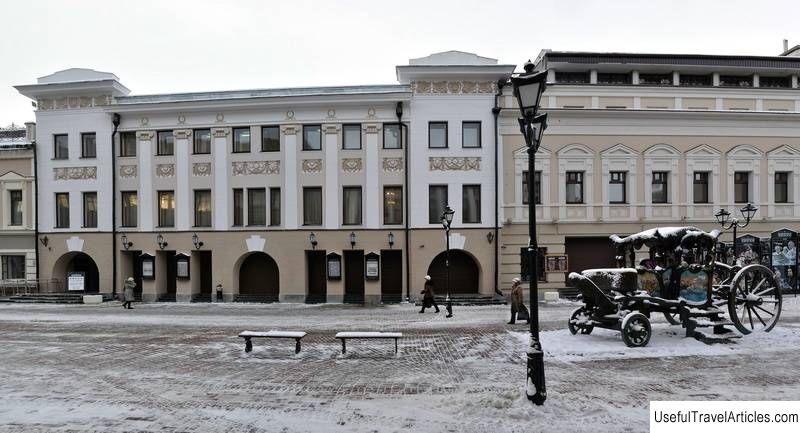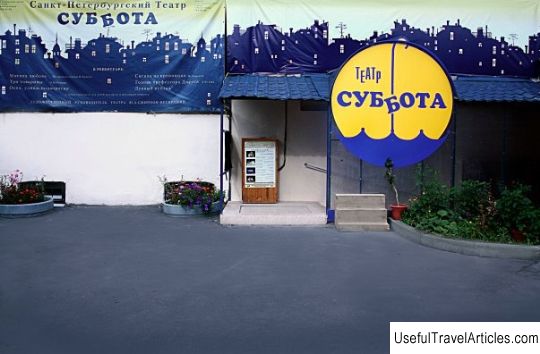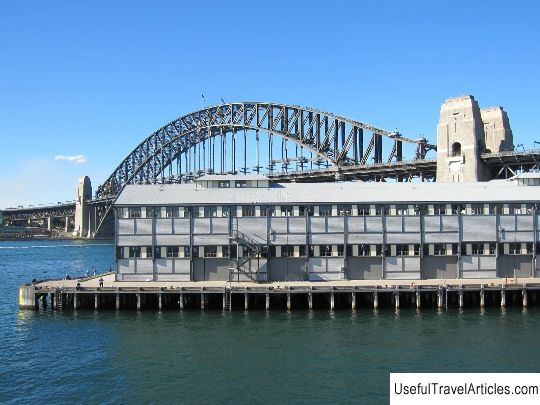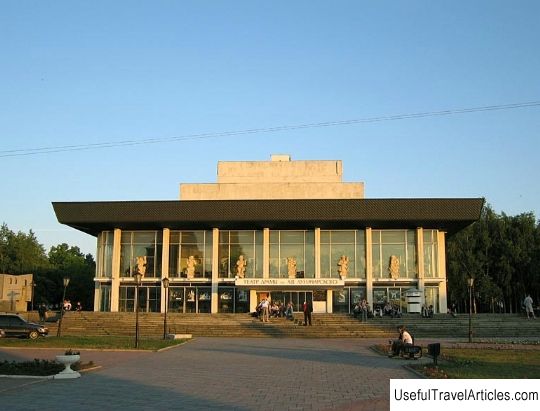Alexandrinsky Theater description and photos - Russia - Saint Petersburg: Saint Petersburg
Rating: 8,3/10 (502 votes) 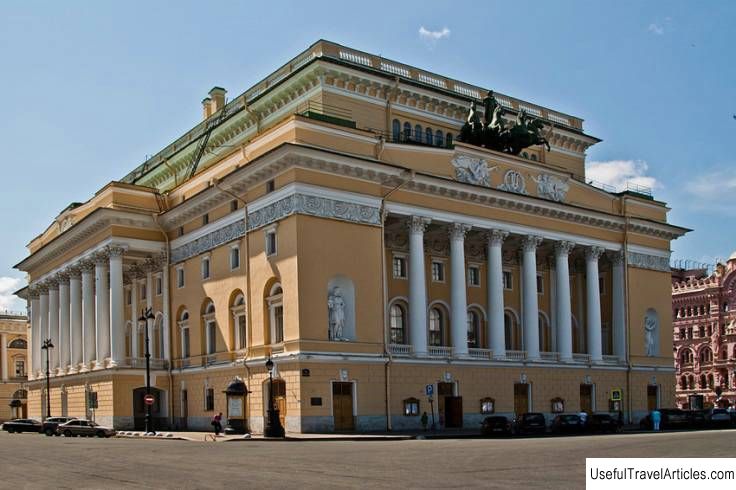
Alexandrinsky Theater description and photos - Russia - Saint Petersburg: Saint Petersburg. Detailed information about the attraction. Description, photos and a map showing the nearest significant objects. Photo and descriptionIn the cultural capital of Russia, there is one of the oldest theaters in our country (from among those that have survived to the present day), founded in the 50s of the 18th century by Empress Elizaveta Petrovna , Is the Alexandrinsky Theater, also known as the Pushkin Theater. The troupe of this famous drama theater has toured all over the world, and everywhere its performances have enjoyed constant success. The theater building was designed Carl Rossi. It is built in accordance with the canons of the Empire style. In the XXI century, the second building of the theater was built - the New Stage. It is a unique multifunctional center that has no analogues in the world. Theater buildingFor quite a long time, the theater troupe did not have its own premises, using the buildings of other theaters. Only seventy-six years after the founding of the troupe, it finally got its own building. The theater was built in the beginning of the 30s of the XIX century . The territory on which it was erected previously belonged to the Anichkov family and was occupied by a huge garden. To be more precise, the owner of the territory in the 18th century was the same colonel under whose leadership the famous Anichkov Bridge was built. Later, the treasury bought the land from him, and the construction of the theater began. At first, the building was made of wood and was intended not at all for a “homeless” troupe of Russian actors, but for an Italian opera . Later, a small wooden building no longer met the needs of the city, it was decided to build a new building, this time from stone. The implementation of this plan was put by the military conflict with Turkey, then the war with France broke out ... The construction of the theater was postponed indefinitely. At the beginning of the 19th century, Karl Rossi created several projects for a new building. He worked on these projects for about ten years. In the late 1920s, construction work finally began. After about four years, a new magnificent theater building was completed. Nowadays it is one of the main architectural landmarks of the city. The deep loggia with many columns gives a special majesty to the main facade of the building. The main decoration of the side facades is also columns (eight on each side). A street leads to the building, making up a single ensemble with it. This was the intention of the architect, who designed not only the theater, but this street as well, who combined them into a single composition. A rather short street is closed by the theater building, or rather, its rear facade, which is almost flat, but is distinguished by a rich decor. A few words should be said separately about the sculptures that adorn the walls of the theater. They were created by Vasily Demut-Malinovsky . This is an antique chariot, ancient Greek muses, theatrical masks, laurel wreaths ... Together with the columns, Attic and other elements of the building, these sculptures are, as it were, parts of an architectural symphony created in the 19th century by two authors - a renowned architect and a famous sculptor. Speaking about the theater building, it is necessary to say a few words about the original structure of its vault. In the 19th century, this design was an innovation. The architect had to defend this unusual engineering solution, to defend it from the attacks of many contemporaries. He was firmly convinced of the reliability of the design he proposed (and, as time has shown, this confidence was quite reasonable). The architect even offered to immediately hang it right in the theater - in the event that his proposed engineering solution causes some kind of misfortune. Building interiorsThe interiors of the theater are also worthy of a separate description. The hall is five-tiered . It was created according to the most progressive system for the 19th century. The acoustics of the hall are beyond praise. The elegant interiors of the theater today are almost the same as they were in the 19th century. However, it should be noted that initially blue upholstery was used in the hall, but at the end of the 1840s it was replaced by crimson . The reason for this change was the most commonplace: at that time oil lamps were used in the theater, which were heavily smoked, so that the original upholstery was seriously damaged. The soot also damaged the wall paintings, so they had to renew them. The same thing happened with plafond painting. Speaking about the changes that took place in the theater interiors at that time, the stage should also be mentioned: for a number of reasons, it was heavily redesigned. When visiting the theater, pay attention to the luxurious carvings that adorns the boxes: its drawings were made by the author of the building project. The ornament, which decorated the barriers of the tiers, was created later - in the second half of the XIX century. Theater in the XIX-XX centuriesThe theater received its name in honor of Alexandra Feodorovna, wife Nicholas I . Throughout the 19th century, this theater was one of the main centers of culture not only in the northern Russian capital, but throughout the country. At first, the troupe was guided by the traditions of European performances, but gradually, year after year, its original style began to take shape, own school. The most popular genres in the first half of the 19th century were comedy performances, and the audience also willingly bought tickets for vaudeville. Perhaps the reason was that a difficult war with Napoleon was left behind, after the horrors of which people wanted positive emotions, lightness and fun. By the way, it was then that the early comedies of Alexander Griboyedov were staged on the stage of the theater. Since the audience preferred vaudeville , St. Petersburg actors had to improve their plasticity, be able to combine movement and singing. It was then that critics began to contrast the theater schools of Moscow and St. Petersburg. It was believed that in the northern capital, more emphasis is placed on external skill than on genuine acting talent. However, both schools were rated very highly. The theater enjoyed particular attention of Russian emperors, especially in the first half of the 19th century. In the part of the history of the theater that spans the 20th century, there are several main periods and key events. - Immediately after the 1917 revolution, the theater was closed down : this was done as a protest against the new government. However, this "sabotage", which lasted about four or five months, did not have any large-scale consequences. After a while, the performances in the theater resumed. - In the 20s of the XX century, the theater began to be called the “mecca of directors”. By that time Vsevolod Meyerhold has already staged several performances on his stage. "Don Juan" by Moliere and "Masquerade" based on the drama by Mikhail Lermontov made an indelible impression on the audience. - In the early 30s, a solemn celebration of the centenary of the theater building took place. It has become an important event in the cultural life of not only the city, but the whole country. However, this anniversary, as it were, deleted from the history of the troupe those seventy-six years when it did not have its own building. This was done for ideological reasons, because otherwise one would have to remember that the theater was founded by the Russian empress, and its troupe was originally a courtier. - At the end of the 30s the theater was named Alexander Pushkin . By the way, in the first decades of the 20th century, the theater was sometimes called "Ak-drama" (the word "ak" is an abbreviation for the adjective "academic"). - In wartime, the troupe was evacuated across Lake Ladoga (covered with ice). The theater continued to work in Novosibirsk. - In the early 90s, the famous St. Petersburg theater was returned to its historical name. Present timeOne of the brightest moments in the history of the theater in the current century was the proposal of the Ministry of Culture of the Russian Federation to merge the Alexandrinka with the Yaroslavl Drama Theater (Volkovsky). What should have been the result of the merger was planned to be called Russia's First National Theater . But this initiative was not implemented, as the public assessed the merger of theaters negatively. However, the project was not completely rejected by the Russian authorities, its implementation was only suspended. By the way, some art workers assess the possible unification of the two theaters as the right step that will help the development of Russian culture and give new opportunities to directors and actors. Let's say a few words about Volkovsky Theater . It was founded in the 1850s and is the oldest drama theater in the country. Its building is located in the central part of Yaroslavl. Residents of the city and the entire Yaroslavl region are proud of this theater, consider it to be their property and actively oppose its unification with Alexandrinka. In their opinion, such a union will actually destroy one of the main attractions of Yaroslavl, making the oldest Russian drama theater only an appendage of Alexandrinsky. Some believe that the brilliant Yaroslavl actors on the St. Petersburg stage "shine" only extras. However, many are sure that the unification of the two famous theaters will nevertheless take place sooner or later, despite the numerous objections of the residents of both cities ... Notes
         We also recommend reading Aquarium ”Le Navi” (Le Navi Aquarium) description and photos - Italy: Cattolica Topic: Alexandrinsky Theater description and photos - Russia - Saint Petersburg: Saint Petersburg. |

